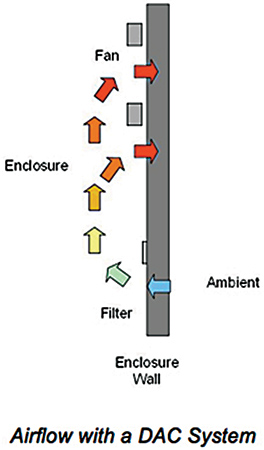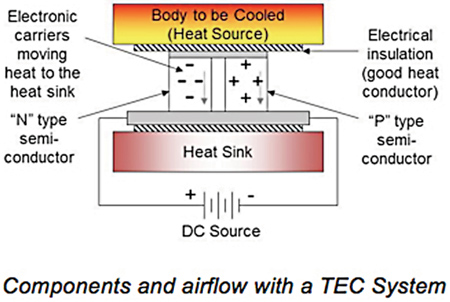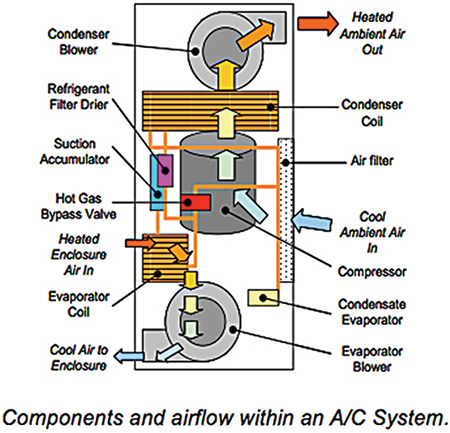Battery backup systems play a critical role in keeping utility substations online in case of outages. Serving as primary or secondary power, battery backup systems enable the station’s feeds to trip in the event of a fault, as well as activate the low-voltage main breaker and high-voltage protection of the power transformer. Additionally, the presence of a battery backup system provides reliable power for switchgear and critical standby systems during loss of AC power.
As utilities look to expand the capabilities of their facilities, space becomes a consideration. Having the ability to move battery backup systems outdoors creates space and ultimately minimizes infrastructure costs related to adding brick and mortar to an existing facility. The use of thermally managed outdoor enclosures offers an effective way to ensure that batteries used in backup systems perform at their peak in rugged, outdoor environments.
When considering implementing an outdoor battery backup system, it is recommended to consider a thermally managed enclosure that complies with North American Electric Reliability Corporation (NERC) standards for battery maintenance and monitoring.1 Additionally, the batteries should be able to recover quickly and survive Partial State of Charge (PSOC) conditions, harsh weather and extreme temperatures. Keeping batteries in their optimal temperature range helps foster high performance and long life of the complete backup power system, with high reliability and low operating expenses.
Enclosures for battery backup systems should be able to:
- Accommodate the full range of applications needed, from initial deployment to large-capacity applications
- Expand with the growth of the application
- Offer a wide range of thermal management technologies to handle seasonal temperatures and humidity, as well as thermal loads produced by internal active equipment
- Prevent moisture ingress
- Consume minimal parasitic power
- Secure the system from unauthorized access
Considerations for Implementing an Outdoor Battery Backup System
There are many factors to consider when implementing an outdoor battery backup system for use in a substation or other utility applications:
Remote Locations
Remote locations can be inaccessible and plagued by unstable grids, frequent outages, and extreme and varied weather conditions. Batteries in an outdoor backup system must be designed to handle these conditions, recover quickly, and survive PSOC and harsh weather. A hybrid approach may incorporate generators, solar power and batteries, for example, which helps prevent interruptions of electrical service.
Battery Selection
A properly sized outdoor battery backup system should be able to support any specified substation load profile. This includes complex load profiles with continuous, non-continuous, momentary and even random loads. A properly sized battery system that is temperature controlled inside an outdoor enclosure ensures maximum site reliability.
Some battery manufacturers are turning to specialized manufacturing processes to develop batteries that reduce ownership costs, while outperforming other batteries. For example, Thin Plate Pure Lead (TPPL) batteries with ultra-thin, corrosion-resistant plates offer more power and energy density, as well as a longer shelf life, than similarly sized batteries. These features along with the thermally managed cabinet add an additional layer of reliability to the battery backup system.
Thermal Management
Many factors affect the thermal performance of an outdoor enclosure, including the thermal load produced by the sun and the equipment inside. While some batteries in outdoor battery backup systems may be more temperature tolerant than others, all batteries in outdoor locations can benefit from the protection of a thermally controlled outdoor enclosure. Thermal management has become increasingly available for outdoor battery enclosures in order to maintain an ideal temperature of 77 degrees Fahrenheit (25 degrees Celsius).
Enclosures with thermal management features can have a large impact on outdoor battery backup systems and can affect operational expenses. If the enclosure does not have thermal management features, it will not have the capability to maintain the proper operating temperature for the batteries. Manufacturers now offer a range of technologies and capacities to match thermal management requirements. Options include Direct Air Cooling (DAC), Thermo-Electric Coolers (TEC), Air Conditioning (A/C) and zone cooling. These technologies help maintain the appropriate thermal environment for equipment, while minimizing ownership cost.

Figure 1: In DAC systems, air flows between batteries as it exchanges
heat with the battery walls before being exhausted from the enclosure.
- DAC systems provide excellent above-ambient thermal management performance that is ideal for deployments in locations with moderate annual temperatures. DACs use open-loop systems that bring outdoor ambient air into the enclosure’s interior for cooling purposes. The air flows between the batteries as it exchanges heat with the battery walls before being exhausted from the enclosure.
DAC systems normally employ inexpensive mesh filters to prevent particulate contamination from entering the enclosure or, alternatively, can be equipped with high-performance hydrophobic filters that prevent moisture entry. DAC systems are highly reliable and consume little energy, which makes them well suited for operation during commercial power outages due to their low parasitic power consumption from the batteries. They also have long life expectancy; the only moving parts are the fans.
- TECs use the Peltier effect, in which current applied across two dissimilar materials causes a temperature differential. Heat moves from one side to the other, where, typically, a heat sink will absorb it. The cooler side is used to cool the environment inside of the enclosure.
TECs offer variable and scalable incremental cooling and heating in a compact form factor and are ideal for deployment in any temperature climate. TECs also offer high reliability and long life expectancy because, as with DAC systems, the fans that circulate air are the only moving parts. They require minimal maintenance and can operate on battery backup during commercial power outages. In general, a TEC will consume more power than a DAC.

Figure 2: In TEC systems, heat moves from one side
to the other, where, typically, a heat sink will absorb it.
- A/C is based on liquid absorbing heat when it evaporates; this liquid is referred to as the refrigerant. Refrigerants absorb heat by changing from liquid to vapor (evaporation), which cools the enclosure. A/C is energy efficient, as there is a small amount of energy loss during the cycle, and it can manage a large heat load, making it reliable in even very high-temperature climates.
A/C is among the highest performing thermal-management technologies, as it is able to support high heat loads and cool an enclosure’s interior far below ambient air temperatures. Most A/C units deployed in support of outdoor enclosures are closed-loop systems based on a vapor compression cycle. The refrigerant undergoes a change of state (from liquid to gas) that absorbs thermal energy from within the enclosure and transfers it to the outside air. This process also removes humidity from the enclosure.

Figure 3: Most A/C units in outdoor enclosures are closed-loop systems based on a vapor
compression cycle: The refrigerant changes from liquid to gas, absorbs thermal energy
from within the enclosure and transfers it to the outside air.
- Zone cooling separates the enclosure into multiple zones, each using a thermal management technology selected specifically for the equipment or components deployed in each zone. This capability is especially useful for enclosures that house both batteries and electronics.
Enclosures with Expandability
Enclosure systems should be adaptable to changing applications and environments so operators may standardize one enclosure model that accommodates different equipment configurations and deployment challenges.
Conclusion
As utilities expand, so does the demand for space. The use of NERC-compliant, thermally managed outdoor enclosures to house backup battery systems not only provides more space inside facilities for personnel and other equipment, but also ensures that backup batteries are secure and protected from the elements. The availability of a range of thermal management methods enables utilities to select the appropriate backup battery outdoor enclosure to fit their particular needs, even in remote locations. The NERC-compliant, thermally managed outdoor enclosure system chosen should also be expandable to respond effectively to changes in the utility’s operations, as well as employ high performance batteries of the appropriate size.
About the Author
 George Brendahl has worked at EnerSys since 2006, where he currently is responsible for utility and nuclear products and provides technical support for applications in the utility markets.
George Brendahl has worked at EnerSys since 2006, where he currently is responsible for utility and nuclear products and provides technical support for applications in the utility markets.
1 North American Electric Reliability Corporation (NERC), “Protection System Maintenance,” Nov. 7, 2012,
Standard PRC-005-2, p 1, accessed at http://www.nerc.com/files/PRC-005-2.pdf







